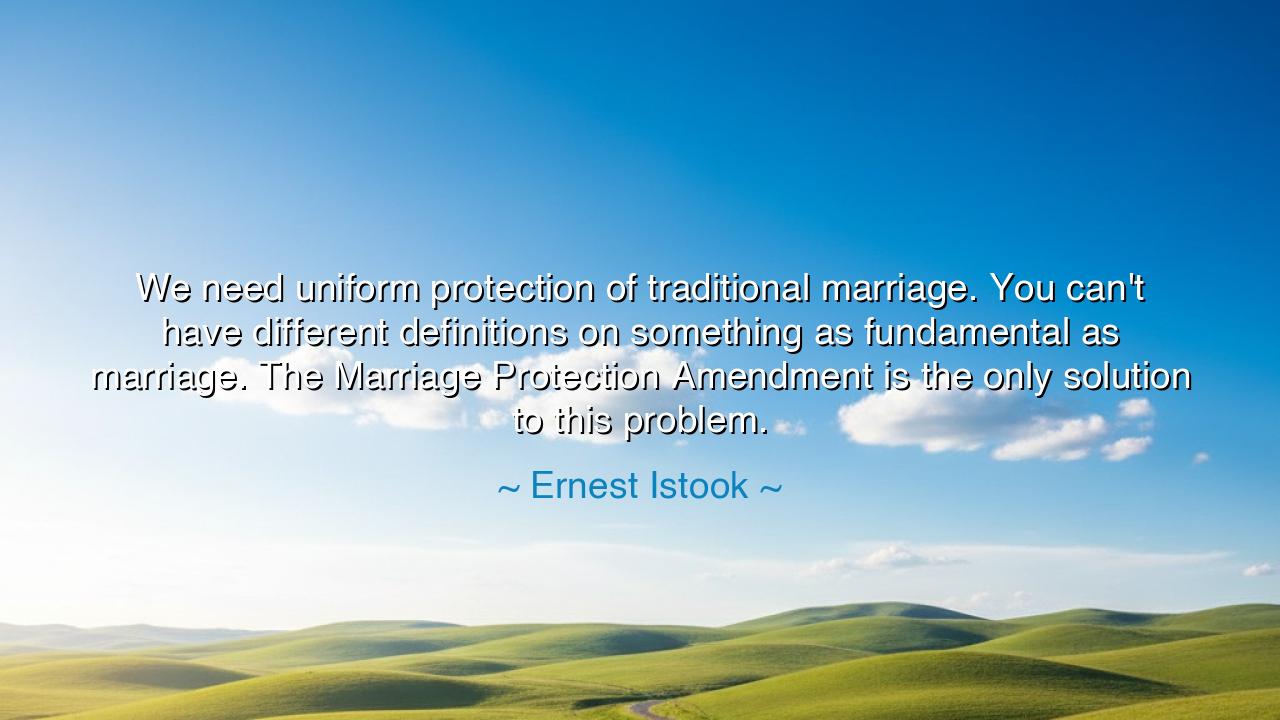
We need uniform protection of traditional marriage. You can't
We need uniform protection of traditional marriage. You can't have different definitions on something as fundamental as marriage. The Marriage Protection Amendment is the only solution to this problem.






“We need uniform protection of traditional marriage. You can’t have different definitions on something as fundamental as marriage. The Marriage Protection Amendment is the only solution to this problem.” — Thus spoke Ernest Istook, with conviction and concern, in an age of moral and cultural upheaval. His words were not uttered in simplicity but in the midst of fierce debate, when the very definition of marriage was being questioned, reshaped, and reimagined across the United States. In his declaration, we hear both the voice of tradition and the cry of uncertainty — a plea for unity in a time of division, for order in a world where values seemed to shift like sand beneath the nation’s feet.
To understand the depth of Istook’s words, one must first see the world from which they arose. In the early years of the twenty-first century, the question of marriage — what it was, and who could enter into it — became a defining battle in the American moral landscape. Some states began to recognize same-sex unions, while others held fiercely to the ancient model of man and woman joined under divine and civil law. Courts ruled one way, legislatures ruled another. And amid this cacophony, Istook called for a single voice, a uniform protection, so that the sacred institution, as he saw it, would not splinter into fragments of conflicting meaning.
To him, marriage was not merely a social contract, but a pillar of civilization, the cornerstone upon which families, communities, and nations were built. He believed that allowing each state or court to redefine it at will would unravel the threads of moral coherence that bound the people together. For if one state proclaimed one truth, and another a different one, then what remained constant? Without shared principles, he feared, the very foundation of society — the family — would weaken, and from that weakness, greater divisions would follow. Thus he sought refuge in amendment, that most enduring of instruments, carved into the Constitution itself, where fleeting passions could not easily reach.
The Marriage Protection Amendment, which Istook championed, was proposed as a safeguard — a way to fix in law what tradition had long held in spirit. It echoed the desire of many who saw themselves not as oppressors, but as guardians of heritage, preserving the customs of faith and family against what they perceived as a cultural storm. To them, marriage was not a matter for interpretation, but an eternal truth — as old as Adam and Eve, as sacred as the vows sworn before God. In this vision, different definitions did not signify progress, but confusion — a fracturing of the social order into a thousand competing truths.
And yet, the currents of history are never still. Across the nation, voices rose in opposition — voices that spoke not of protection, but of inclusion. They told of love denied, of families unrecognized, of hearts yearning for equality under the law. They invoked the Constitution not to preserve the past, but to expand its promise. For them, the problem was not that marriage was being redefined, but that it had been too narrowly defined for too long. Thus the great debate continued, and still continues — between those who seek constancy and those who seek transformation, between the safety of tradition and the freedom of evolution.
To reflect on Istook’s words is not to dismiss them, but to understand their longing: the yearning for a moral compass in an age of change. Every civilization faces moments when it must decide what it will carry forward and what it will release. The ancients knew this tension well. When Solon of Athens crafted the laws of his city, he said, “I have given the people not the best laws, but the ones they could endure.” So too with marriage and tradition — the laws of the heart must evolve with the heart of the people, yet they must not lose their anchor in meaning.
Thus, the lesson for those who live in the present is not to mock the fears of the past nor to reject the dreams of the future, but to seek wisdom between them. If you hold to tradition, do so not out of pride, but out of love for stability. If you embrace change, do so not out of rebellion, but out of compassion for those still unseen. The strength of a society lies not in uniformity of belief, but in respectful dialogue — in remembering that every argument about law is truly an argument about what it means to live rightly together.
And so, O listener, take this teaching to heart: when debates of morality and justice arise, let your voice be firm but your spirit humble. The words of Ernest Istook remind us that even as we differ, we all seek the same thing — the preservation of what we hold sacred, and the assurance that love, family, and faith endure. Whether through amendment or evolution, may our pursuit of truth be guided not by fear, but by wisdom — that ancient light which has always led humankind through the tempests of change toward the calm shores of understanding.






AAdministratorAdministrator
Welcome, honored guests. Please leave a comment, we will respond soon